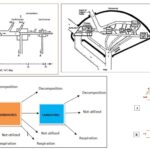Biochemistry 16 Views 1 Answers
Sourav PanLv 9April 18, 2025
What does Krebs cycle produce?
What does Krebs cycle produce?
Please login to save the post
Please login to submit an answer.
Sourav PanLv 9May 15, 2025
The Krebs cycle produces several key molecules per turn: 3 NADH, 1 FADH₂, 1 GTP (or ATP), and 2 CO₂. It also regenerates oxaloacetate, the molecule required to initiate each new cycle turn. The NADH and FADH₂ produced carry high-energy electrons to the electron transport chain for ATP production. CO₂ is released as a metabolic waste product. The cycle also provides intermediate compounds for biosynthesis of amino acids, nucleotides, and other biomolecules.
0
0 likes
- Share on Facebook
- Share on Twitter
- Share on LinkedIn
0 found this helpful out of 0 votes
Helpful: 0%
Helpful: 0%
Was this page helpful?




